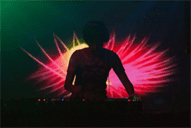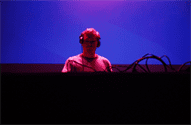The Science Behind DJing
Wednesday, January 11, 2017
by Tat
A few weeks ago we looked at some of the scientific literature that had been written about clubbing. This week's blog post we thought it would be interesting to explore some of the academic research that has been written about the craft we love so much - the art of DJing.
Yes there is research about DJing
The issue of the digital DJ and how they interact with their audience was investigated in 2010 for the University of Cambridge's publication "Popular Music". The article by Montano asked the question; "How do you know he's not playing Pac-Man while he's supposed to be DJing? Technology, formats, and the digital future of DJ culture. Montano makes a couple of assumptions, firstly that all DJs are male when we know that is far from the truth and that the game of choice for DJs is pacman, when we clearly know it's Pokemon. The aim of the article was to look at some of the conversations and reactions by DJs between 2002 and 2007. Montano wrote: "The physical movement required to mix vinyl records has meant that the associated skills of DJing have become bound up in notions of physical and visible manipulation of technology, and so the use of technology that does not require and afford such physical expression has raised questions around the fundamental skills of DJing". That meaning if you are using a laptop and not decks then we can possibly assume you are checking your emails and not live DJing. Of course many would disagree that those who DJ without vinyl do still present some kind of physical expression that goes beyond just holding their arms aloft in the air. As we wrote in our article about sync, some DJs believe that not having to manually mix and use sync gives them time to do other things. The flip side of this is that there is no shortage of DJs who do just hit sync, hold arms aloft and repeat this formula throughout their session, thanks to the need to be less physical in their act.
The human and computer interaction
The whole virtual, digital and physical DJ discussion is also picked up by research from Lopes and colleagues. Their research titled "Battle of the DJs: an HCI perspective of traditional virtual, hybrid and multi touch DJing". The research was published in the Proceedings of the International Conference on New Interfaces for Musical Expression held in Oslo in 2011. The purpose of the paper was to present a classification of DJ tools in addition to presenting a multitouch tabletop application. The paper goes in depth looking at multitouch DJing and their application which they found useful for club and radio DJs but much less so for scratch DJs for in their conclusion: "due to the lack of haptic feedback of turntable motion."
Society and the DJ
Much of the research that has been carried out that looks at the DJ has focused on a few key topic areas. These being the social aspects of the DJ, where they sit in society and their impact, the technology around DJing and how the DJ interacts with it. One paper by Karnik titled "Peripheral interaction in the context of DJing". The paper looked at how a DJ balances their technical interaction, that being with their DJ kit and their social interaction, that being with the audience. It is a very tough balancing act for any DJ, even going back to the 1970s, to deliver a superb set, use the kit expertly and interact with the audience, or at least monitor how things are going outside of the DJ booth. The author even got involved with their target group to the extent of DJing themselves to understand the issues between technology and social interaction. Karnik wrote: "As part of this process, the lead author of this work has been engaged in long term ethnographic studies of DJs and, in the spirit of overt 'participant observation', has performed 12 gigs over the last two years in the capacity of both a DJ and a VJ". The conclusion of the research was to propose; "working on a few design directions that have resulted into a number of concepts for the nightclub settings. One of the concepts is a tangible interface or an interactive system for the DJs that would be connected to projectors beaming colored blobs downwards onto the crowds on the dance floor. The DJs will be able to interact with sections of the crowd by manipulating these color blob projections". Whether this research has come to fruition only those who have danced under the light of coloured blobs will know, which could just about be anyone.
The skill of the DJ
The skill of DJing is covered in "Two studies investigating the value of DJing for contemporary music education". The Master's Thesis was authored by McCutcheon in 2014 and investigated the importance of cognitive skills learned through DJing and perspectives on the potential value of DJing for music education. The first study interviewed DJs about their perspectives on the potential value of DJing for music education. The second study was data driven and investigated the cognitive abilities derived from formal and informal music learning. The research concluded that further work needed to be carried out and confessed that having a small sample size of DJs also limited it. McCutcheon concluded that: "Future research might also assess the views of a wide sample group of formal music educators in order to establish how DJing might be integrated into a school curriculum. Interviewing DJing instructors may also yield data as to how a "formal" educational methodology for DJing lessons might be implemented."
DJing and wellbeing
A health angle is also included in the literature as the paper 'Embodied and distributed parallel DJing' was published in the journal Studies in Health Technology and Informatics. The research was from a project called RHYME and looked at the innovative potential of including people with special needs, when creating new cultural activities. The project's goal was to create health promoting activities for children with severe disabilities, by developing new musical and multimedia technologies. The research found: "Because of the users' extreme demands and rich contribution, we ended up creating both a new genre of musical instruments and a new art form. We call this new art form Embodied and Distributed Parallel DJing, and the new genre of instruments for Empowering Multi-Sensorial Things."
How DJs and electronic music is perceived
Vandemast-Bell carried out research which you can find on the University of Derby's open access repository and was published by Contemporary Music Review that was titled; 'Rethinking live electronic music: a DJ perspective'. His work critiqued the conventional understanding of live electronic music through research on his own DJ practice whilst investigating his peers. He argued the notion that; "The DJ as a real-time composer working beyond traditional binary distinctions who brings the human body and machine into a mutual relationship". Most notably from his work he found out what many DJs have experienced or to some extent feel. He wrote: From my investigations in the live electronic music genre I became aware of a particular dislike for Club DJ practice; whereas those around me had lightly mocked my apparent lack of musicianship and my penchant for music made with machines, live electronic musicians were resolute in their claims that the Club DJ was categorically not a musician, DJ-ing was not a live art form, and electronic dance music artificial."
The rise of the digital DJ
Over at the University of California Levitt submitted her dissertation titled 'Turning the tables, nightlife, DJing and the rise of digital DJ technologies.' Published in 2016, the research looked at the history of the DJ and how DJs had repeatedly adopted new technologies. The author looks at the multitude of formats and platforms for DJs to engage with and how the whole scene has evolved. Levitt concludes; "The shift to digital DJing opens up possibilities for more democratic involvement, particularly for women in what has long been a male-dominated art form". The final paragraph emphasises how digital DJing opens up access to new DJs when vinyl and turntables are not accessible. Levitt's final lines read most interestingly It could also lead to exciting sonic experiments and artistic practices. And isn't that what DJing is all about?
I think we can all agree about that. We will hopefully carry on with our investigations into the work being carried about scholars into DJing, electronic music and club culture in future months as there seems to be no lack of research being conducted in this area. Some of it useful, other content telling us what we already know, but the fact it is explored within academia can only be a good thing. It adds credence to the art form and helps explore the new technologies that align to the culture. The more that is written which is positive, the more others will come to understand DJing as an important part of modern society and culture
Bibliography
- Cappelen, B. & Andersson, A., 2016. Embodied and Distributed Parallel DJing. Studies in health and technology
- Einstein, A., As a process, DJing is inevitable and necessary for our times.—Jace Clayton (AKA DJ/rupture). dmistudio.org
- Levitt, K., 2015. Turning the Tables: Nightlife, DJing, and the Rise of Digital DJ Technologies
- Lopez, P., Ferreira, A. & Pereira, J., 2011. Battle of the DJs: an HCI Perspective of Traditional, Virtual, Hybrid and Multitouch DJing. NIME
- MacCutcheon, D., 2014. Two studies investigating the value of DJing for contemporary music education
- Montano, E., 2010. "How do you know he"s not playing Pac-Man while he's supposed to be DJing?': technology, formats and the digital future of DJ culture. Popular Music, 29(3), pp.397–416
Discover your first digital dance music in 2017 with Trackhunter







